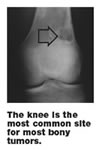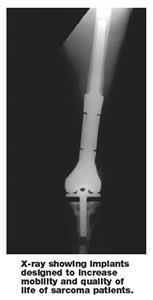You’re Not Alone
The first thing you should know is that you are not alone. Most people are surviving sarcoma in the world today. Previously sarcomas were managed with radical resections with no attention paid to function. In the past two decades, significant progress has occurred in the management of patients with musculoskeletal cancers, that has improved both the survival and the quality of life of afflicted patients. Changes in the management of these patients have mirrored trends in the entire field of oncology.
To put your diagnosis in context, you should know a little about sarcoma and its place within the range of cancers. The annual incidence in the United States, which remains relatively constant, is approximately 6,000-7,000 soft tissue and 2,500 bone sarcomas.1 In comparison, the estimated number of new cancers in 2005 was 1,372,910.2
With a rare and complex disease such as sarcoma, it is important to seek the best possible care to improve your chance of survival. You should consider a team approach to your care. A medical oncologist, radiation oncologist and orthopaedic surgeon will work together to treat your sarcoma. Pain management specialists, social workers and physical therapists assist in your treatment plan.
If you’re reading this website you are taking a good first step, and it is encouraged that you learn more about your treatment options so that you can participate fully in your care.
Understanding the Basics
Understanding the basics can be overwhelming. Below are some frequently asked questions to help you understand the disease and potential treatment options.
What is the difference between a benign and a malignant tumor?
Malignant tumors (“cancers”) are capable of spreading to other parts of the body whereas benign tumors cannot spread. Some benign tumors are called “aggressive” because they can destroy nearby bones and soft-tissues yet do not spread to other body sites.
What is a Sarcoma?
Sarcomas are malignant tumors that arise from the musculoskeletal system, bone, fat, cartilage and fibrous tissue.
 What is Osteosarcoma?
What is Osteosarcoma?
Osteosarcoma is the most common type of bone cancer. It occurs in the long bones of the arms, legs or pelvis. It is a primary bone malignancy generally affecting the young between the ages of 10 and 25. 60% of cases occur before age 25 and the peak incidence is at 15 years old.3
What is Ewing Sarcoma?
Ewing sarcoma is a cancer that occurs primarily in the bone of soft tissue. Ewing sarcoma can occur in any bone but is most often found in extremities. Ewing sarcoma can also spread (metastasize) to other areas of the body, including the bone marrow, lungs, kidneys, heart, adrenal glands and other soft tissue. Ewing sarcoma most often occurs in children between the ages of 5 and 20 and accounts for about 30% of all pediatric bone cancers.1
What is the difference between a carcinoma and a sarcoma?
Most cancers (>90%) arise from “epithelial” tissues, such as the inside lining of the colon, breast, lung or prostate.1 These are referred to as carcinomas and usually affect older people. Sarcomas are tumors that arise from tissues such as bone, muscle, connective tissue, cartilage, and fat. Sarcomas occur in young people as well as in adults and comprise less than 1% of all cancers.1 Sarcomas are named the tissue of origin; for example, “osteosarcoma” arises from bone, “liposarcoma” arises from fat and “chondrosarcoma” arises from cartilage.
How is a diagnosis made?
In most cases, your history, examination and imaging studies will predict the diagnosis. However, a definitive diagnosis is not made until a biopsy is performed and tissue obtained for pathological examination.
What is a biopsy?
A biopsy is the removal of a sample of tissue which is examined under a microscope to check for cancer cells. “Minimally invasive” needle biopsies, computed tomography (CT) and guided biopsies are options your medical team may choose.
Diagnosis and Treatment Options
 Your treatment options are specific to you. There are several treatment options, both surgical and non-surgical, which should be considered. Your doctor will recommend treatment plans that are appropriate for you.
Your treatment options are specific to you. There are several treatment options, both surgical and non-surgical, which should be considered. Your doctor will recommend treatment plans that are appropriate for you.
In treating patients with sarcoma, the chief concern is to control the primary tumor and restore function to the patient. Twenty years ago, the standard treatment for any primary malignant bone and soft-tissue sarcomas of the extremities was amputation of the affected arm or leg. Major advances in surgical techniques, chemotherapy and radiation therapy, have revolutionized the treatment of these diseases, and improved patient survival and limb preservation. Today, most patients can be treated by limb-sparing surgery and not amputation.
What is limb-sparing surgery?
Limb-sparing surgery is now a safe and effective method of treatment for many, if not most, individuals. The goal of limb-sparing surgery is the complete removal of the tumor with preservation of limb and function. Surgeons often utilize systems like Stryker’s Global Modular Replacement System (GMRS) to reconstruct bone and joints, due to its durability and flexible surgical options. The GMRS System permits early mobilization for patients that want an all-in-one solution that is designed to retain a quality and spirit of life after bone cancer surgery.
A Final Word: The Decision Is Always Yours
As with any illness, you must learn to be your own advocate and work together with the healthcare team to make informed decisions. Experts will make recommendations based on their knowledge and experience, but it is ultimately up to you, the patient, to decide what is best for you. Talk to your doctor about your treatment options.
References:
1. Martin M. Malawer and Paul H. Sugarbaker, “Musculoskeletal Cancer Surgery Treatment of Sarcomas and Allied Diseases,” Kluwer Academic Publishers, 2001.
2. Jemal, et al., Cancer Statistics, 2005, CA: A Cancer Journal for Clinicians, 2005: 55: 10-30.
3. Nagarajan, R., et al., “New Paradigms for Therapy for Osteosarcoma,” Current Oncology Report, November 2005; 7(6): 410-4.